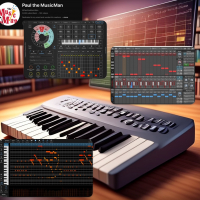Loopy Pro: Create music, your way.
What is Loopy Pro? — Loopy Pro is a powerful, flexible, and intuitive live looper, sampler, clip launcher and DAW for iPhone and iPad. At its core, it allows you to record and layer sounds in real-time to create complex musical arrangements. But it doesn’t stop there—Loopy Pro offers advanced tools to customize your workflow, build dynamic performance setups, and create a seamless connection between instruments, effects, and external gear.
Use it for live looping, sequencing, arranging, mixing, and much more. Whether you're a live performer, a producer, or just experimenting with sound, Loopy Pro helps you take control of your creative process.
Download on the App StoreLoopy Pro is your all-in-one musical toolkit. Try it for free today.
Tutorial: How to Import Scaler 2 Chords to the Chord Track in Logic Pro 2 for iPad Quickly
There's a very quick and easy way to get your chord progression from Scaler 2 into Logic Pro 2.0 for iPad. This video demonstrates one way to do it. There may be better and more effective ways to get the job done, so feel free to chime in with any suggestions.
How to Import Scaler 2 Chords to the Chord Track in Logic Pro 2 for iPad Quickly



Comments
Very good suggestion, thanks!
Oh man. This is great. I tried the method that David from the scaler folks used for the desktop with no success, but this method works. Oh heck yeah.
Thanks for posting this, I was trying to figure it out myself - I didn't realise you could edit the chords from the inspector, I was using the panel that pops up when you tap a chord, but that doesn't work for this method.
Bonus tip: you can copy chords from the chord track and paste them as MIDI onto any MIDI track!
Here are a some related tips to go with the video that I was either not able to cover or found later:
I highly recommend experimenting with the chord tracks feature and seeing what else you can do with it - it really opens an entire new dimension for working in Logic Pro. I don't have Logic Pro 11, but I suspect a lot of these things can be done in a similar way there, and it probably has more flexibility.
Thanks for the tips here. I didn’t know you could copy and paste the chord progressions to a midi clip, and found the library has a ton of session player loops which are well made.
Also just noticed the keyboard player has a manual mode too so you can program your own rhythm into it - don’t know how I missed that.
This had turned out to be a really great feature update with a lot more depth than I originally thought.
Agree!
As an inspiration, these new groundbreaking features in Logic Pro v2/v11 can do magic for our musical minds!!
Wish we could program in our own chord progression to add to Logics only six progressions…
Next up to longing for, a guitarist Session Player…
Thanks for sharing this and the other tips. Having a lot of fun with this already.